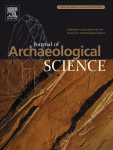| New Volume/Issue is now available on ScienceDirect |
| | Original Research Articles | |
| | 4. | Large-scale 2nd to 3rd century AD bloomery iron smelting in Korea Original Research Article
Pages 1180-1190
Jang-Sik Park, Thilo Rehren
Highlights► Slag from a Korean iron site was examined for microstructure and composition. ► Radiocarbon age by AMS placed the date in the early 3rd century AD or earlier. ► Evidence of an established bloomery smelting technology was found. ► Contact with the north is proposed as a probable source of early Korean iron. ► Questions are raised to the theory of Korean iron originating purely from China.
| |
| | 5. | Preserved epiphytes as an archaeological resource in pre-industrial vernacular buildings Original Research Article
Pages 1191-1198
Rebecca Yahr, Brian J. Coppins, Christopher J. Ellis
Highlights► Timber and wood in vernacular buildings are remnants of historic environments. ► Preserved epiphytes (lichens, mosses) occur on timber with bark in c 70% of vernacular buildings. ► Epiphytes are powerful bioindicators and can be used to understand historic environments.
| |
| | 7. | Faeces deposition on Amazonian Anthrosols as assessed from 5β-stanols Original Research Article
Pages 1209-1220
Jago Jonathan Birk, Wenceslau Geraldes Teixeira, Eduardo Góes Neves, Bruno Glaser
Highlights► Biomarkers show faeces deposition on pre-Columbian Anthrosols in Amazonia. ► Faeces contributed to the fertility of pre-Columbian Anthrosols in Amazonia. ► Faeces could be an important fertilizer for a sustainable agriculture in the tropics. ► Stanol threshold values are inappropriate to evaluate faeces deposition.
| |
| | 8. | Provenance of Early Bronze Age metal artefacts in Western Switzerland using elemental and lead isotopic compositions and their possible relation with copper minerals of the nearby Valais Original Research Article
Pages 1221-1233
Florence Cattin, Barbara Guénette-Beck, Philippe Curdy, Nicolas Meisser, Stefan Ansermet, Beda Hofmann, Rainer Kündig, Vera Hubert, Marie Wörle, Kathrin Hametner, Detlef Günther, Adrian Wichser, Andrea Ulrich, Igor M. Villa, Marie Besse
Highlights► We focus on the north Alpine metallurgy at the beginning of the Early Bronze Age. ► Elemental composition and LI ratios of copper artefacts are investigated. ► A database of copper ores from the Valais (Switzerland) is elaborated for comparison. ► A local ore supply is compatible with the artefactual data. ► Provenance studies using literature data support a (Tuscan?) external influx.
| |
| | 10. | An exploration of character traits and linear measurements for sexing mountain gazelle (Gazella gazella) skeletons Original Research Article
Pages 1253-1265
Natalie D. Munro, Guy Bar-Oz, Austin C. Hill
Highlights► Fifty-three modern mountain gazelle skeletons were studied to determine which measurements best sex archaeological gazelles. ► Discriminant functions to predict sex were derived for each measurement. ► The measurements that provide the most accurate assessment of gazelle sex are identified. ► A regression equation is derived to predict the sex of gazelle from PPNB Motza, Israel.
| |
| | 11. | Hard core and cutting edge: experimental manufacture and use of Magdalenian composite projectile tips Original Research Article
Pages 1266-1283
Jean-Marc Pétillon, Olivier Bignon, Pierre Bodu, Pierre Cattelain, Grégory Debout, Mathieu Langlais, Véronique Laroulandie, Hugues Plisson, Boris Valentin
Highlights► First controlled projectile experiment with Upper Palaeolithic composite spear tips. ► Results outline the penetration power and impact resistance of the antler points. ► Adding lithic insets to the points nearly doubles the penetration depth in the target. ► Manufacture and maintenance of composite tips involve specific technical constraints.
| |
| | 12. | Google earth and the archaeology of Saudi Arabia. A case study from the Jeddah area Original Research Article
Pages 1284-1293
David Kennedy, M.C. Bishop
Highlights► Google Earth high-resolution images of Saudia Arabia. ► Provide access to archaeological monuments in basalt desert. ► Areas not previously covered by aerial photography. ► Complex funerary monuments exploit landscape. ► The Works of the Old Men in Arabia
| |
| | 13. | Spatial dimensions increase the effect of cultural drift Original Research Article
Pages 1294-1299
Joaquim Pérez-Losada, Joaquim Fort
Highlights► Drift can explain the decrease of cultural diversity in the LBK culture in Neolithic Europe, provided that the role of space is adequately taken into account. ► The loss in LBK crop diversity may be a product of spatial drift. ► When spatial dimensions are taken into account, drift has a drastically more significant effect than previously recognized.
| |
| | 14. | A new method to remove copper corrosion stains from stone surfaces Original Research Article
Pages 1300-1307
A. Macchia, M.P. Sammartino, M. Laurenzi Tabasso
Highlights► This research presents a methodological study that led to a innovative cleaning procedure for limestone (namely travertine) surfaces, stained by copper compounds coming from the corrosion of bronze part of artworks. ► The obtained goal is an alternative to the currently used cleaning products, based on ammonia or ammonium salts. Really the last gives not completely satisfactory results. Moreover, it is well known that ammonia is eco toxic and its dispersion in the environment is almost unavoidable during the cleaning procedure; due to its toxicity, restorers need a protection during the cleaning as ammonia is an irritant for skin, eyes, throat and lungs. ► On these bases we can state that our amino acid based solution is not only more effective but also more environmental friendly and safe for the operator than now are used as cleaning solutions.
| |
| | 18. | Paleo-Eskimo kitchen midden preservation in permafrost under future climate conditions at Qajaa, West Greenland Original Research Article
Pages 1331-1339
Bo Elberling, Henning Matthiesen, Christian Juncher Jørgensen, Birger Ulf Hansen, Bjarne Grønnow, Morten Meldgaard, Claus Andreasen, Shfaqat Abbas Khan
Highlights► The kitchen midden in a future climate context can be considered functioning as a peat land. ► The preservation conditions are controlled by freezing temperatures and a high water content limiting the subsurface oxygen availability. ► Threats to the future preservation are related to thawing followed by drainage and increasing subsurface oxygen availability and heat production. ► Field observation and model results suggest a progressive thawing into 1000 years old Thule layers. ► Initial analytic model results indicate that the unique 4000-years Saqqaq layers below more than 1 m of peat is adequately protected against thawing the next 70 years.
| |
| | 20. | The relative effects of core surface morphology on flake shape and other attributes Original Research Article
Pages 1346-1359
Zeljko Rezek, Sam Lin, Radu Iovita, Harold L. Dibble
Highlights► Core surface morphology affects flake size and shape to a limited degree. ► Other independent variables, including exterior platform angle and platform depth, also affect flake size and shape. ► Experimental results supported by analysis of prehistoric lithic assemblages.
| |
| | 21. | Sourcing the interaction networks in Neolithic coastal China: a geochemical study of the Tianluoshan stone adzes Original Research Article
Pages 1360-1370
Tianlong Jiao, Zhengfu Guo, Guoping Sun, Maoliang Zhang, Xiaohui Li
Highlights► We conducted a sourcing study of the stone adzes (5000–7000 BP) of Tianluoshan in eastern China, using geochemical techniques. ► The result demonstrates that about one-third of the lithic raw materials came from the places of at least 50 km away, suggesting the existence of a long distance interaction network. ► Our research results have important implications for studying the early Neolithic seafaring in China because the Tianluoshan was located on the ancient coast.
| |
| | 22. | Obsidian types from Holocene sites around Lake Turkana, and other localities in northern Kenya Original Research Article
Pages 1371-1376
Barbara P. Nash, Harry V. Merrick, Francis H. Brown
Highlights► Electron microprobe analyses (>2000) of artifactual and non-artifactual obsidian from the greater Lake Turkana region, Kenya. ► Fifteen compositional types of obsidian are determined. ► Major obsidian sources for artifact manufacture are not known in the Lake Turkana region. ► The earlier Pastoral Neolithic peoples around Lake Turkana interacted with each other, but perhaps not as strongly with people farther south along the Rift Valley.
| |
| | 23. | Determining the provenance of black limestone artifacts using petrography, isotopes and EPR techniques: the case of the monument of Bocco Original Research Article
Pages 1377-1384
M. Brilli, L. Conti, F. Giustini, M. Occhiuzzi, P. Pensabene, M. De Nuccio
Highlights► The monument of Bocco shows a striking, uncommon, large variation in oxygen and carbon isotopes. ► The article rises the possibility that an important Roman ancient quarry of black limestone has yet to be discovered, probably located in north western Africa. ► An hypothesis of assignment of provenance of the limestone used for the monument is discussed. ► The previous hypothesis about the provenance of the limestone used for the monument can be definitely discarded.
| |
| | 24. | Stable isotope analysis of dog, fox, and human diets at a Late Holocene Chumash village (CA-SRI-2) on Santa Rosa Island, California Original Research Article
Pages 1385-1393
Torben C. Rick, Brendan J. Culleton, Carley B. Smith, John R. Johnson, Douglas J. Kennett
Highlights► Stable isotope analysis of dog, fox, and human remains provides insight into ancient diets and human animal relationships. ► Dogs and humans appear to have eaten generally higher trophic level marine foods, while foxes primarily ate terrestrial foods. ► Stable isotope analysis of dog remains can be used as a proxy for human diets. ► δ13C values in dogs may be enriched relative to humans because people consumed more terrestrial plants than dogs, or perhaps dogs consumed significant amounts of bone collagen that enriched their carbon isotopic signature.
|

Núcleo de Arqueologia e Paleoecologia Laboratório G22 FCHS - Departamento de História, Arqueologia e Património Universidade do Algarve Campus de Gambelas 8005-139 Faro, PORTUGAL Mail: nap.ualg@gmail.comUrl: http://nap-ualg.blogspot.com
|




